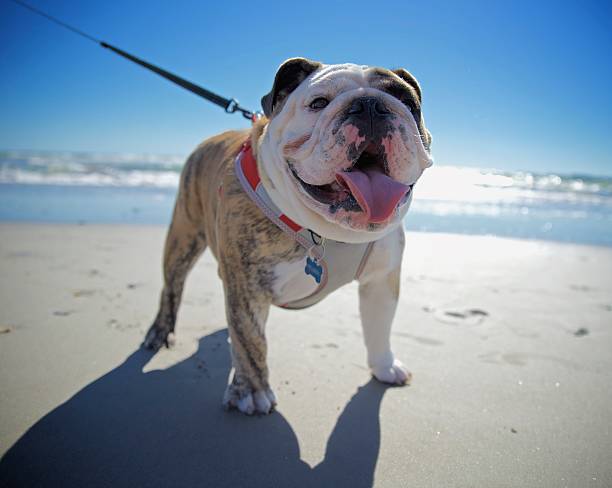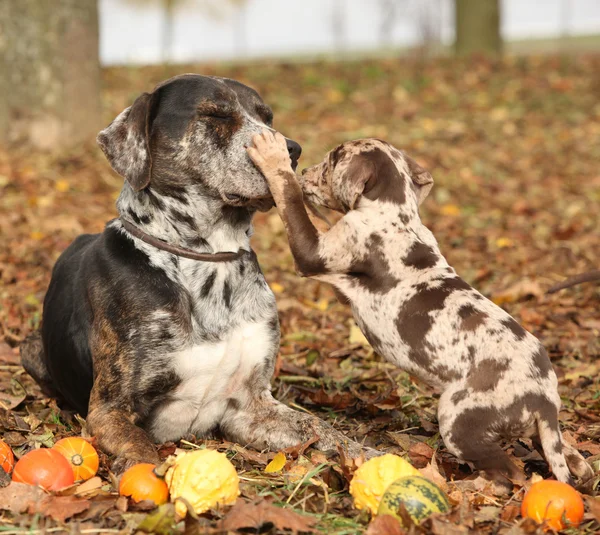The Catahoula Bulldog, a captivating fusion of versatility, loyalty, and fearlessness, captures the hearts of dog enthusiasts and families seeking a fearless companion. With its striking appearance, versatile abilities, and deep devotion, this breed has firmly established itself as a cherished protector and a symbol of the Catahoula heritage.

| Category (Explanation) | Breed Information |
|---|---|
| Year of Breed Conception | 19th century |
| Country of Origin | United States |
| Weight (Male) | 85-100 lbs (39-45 kg) |
| Weight (Female) | 70-85 lbs (32-39 kg) |
| Coat Type | Short, dense |
| Color Variations | Merle, brindle, solid colors |
| Shedding Level | Low to moderate |
| Height (cm & in) | 22-26 inches (56-66 cm) |
| Breed Size | Large |
| Trainability | Moderate |
| Mental Needs | Moderate |
| Intelligence Level | Moderate |
| Energy Level | Moderate to high |
| Agility | Moderate |
| Loyalty | High |
| Playfulness | Moderate to high |
| Exercise Needs | Regular exercise and mental stimulation |
| Guarding Proficiency | High |
| Sociability with Children | High |
| Barking Level | Low to moderate |
| Digging Tendency | Low to moderate |
| Destructive Behavior | Low to moderate |
| Drooling Level | Moderate to high |
| Obedience Level | Moderate |
| Apartment Friendly | Yes, with proper exercise and mental stimulation |
| Inherent Prey Drive | Moderate |
| Physical Risk to Others | Low to moderate |
| Travel Fatality Risk | Low |
| Allergen Potential | Low (considered hypoallergenic) |
| Health Concerns | Hip dysplasia, joint issues, ear problems |
| Average Life Expectancy | 10-14 years |










































































Woof Mastery is reader supported and our articles may contain affiliate links.
Instead of running third party ads that we have no control of we only use links from high-quality companies we are directly partnered with. Making use of these links come at no cost to you our reader, and in many cases have the extra benefit of discounted rates or sign up bonuses.
If you’re interested you can read more about our affiliate policy here.
We appreciate your support and always insure that the products and services we recommend are high-quality, helpful and relevant to the subject at hand!
The Catahoula Bulldog’s history is deeply intertwined with the vibrant culture of Louisiana, USA. Originating from the crossbreeding of local Catahoula Leopard Dogs and Bulldogs, this breed emerged as versatile working dogs. They played essential roles on Louisiana farms, helping with herding livestock and guarding properties.
Their physical prowess, determination, and loyalty made them invaluable to Cajun farmers. Today, Catahoula Bulldogs stand as a testament to the rich heritage of the region, embodying the tenacity and spirit of Louisiana’s unique way of life.
They continue to thrive as loyal companions and working dogs in the bayou country.

What sets the Catahoula Bulldog apart is its versatility and work ethic. These dogs are known for their tenacity and strong work ethic in hunting and herding. Catahoula Bulldogs combine their working abilities with a loving and protective nature, making them a special breed for those who appreciate both companionship and a strong work partner.
Their traditional role was as herders and hunters, helping with livestock and game. They are also loving family dogs.
Catahoula Bulldogs are renowned for their versatile and intelligent personalities. They are fiercely loyal, deeply affectionate, and exceptionally protective of their families. Their intelligence and adaptability make them valuable working dogs and loyal family companions. These dogs have an incredible ability to understand and adapt to various situations, making them not just protectors but also problem-solvers.
Their loyalty to their family is unmatched, and they have a natural instinct to keep their loved ones safe. Catahoula Bulldogs are quick learners and thrive on challenges, making training an enjoyable experience for both the dog and the owner.
While they may approach strangers with caution, their devotion to their owners is unwavering, and they often form strong bonds that last a lifetime. Catahoula Bulldogs truly embody both strength and affection in their character, combining intelligence with unwavering loyalty.
Catahoula Bulldogs are known for their loyal and protective nature. They may display affection towards their families while exhibiting protective instincts that necessitate training and socialization to avoid overprotectiveness. Territorial behavior and occasional stubbornness can be managed with consistent and patient training methods.
Given their strength and size, leash training is imperative. Careful introductions are advised when interacting with other dogs, especially those of the same sex. Early training and socialization are pivotal to fostering a well-adjusted and balanced temperament in this breed.
Catahoula Bulldogs are both dedicated protectors and loving companions.
Catahoula Bulldogs are medium to large-sized dogs known for their strength and versatility. They exhibit a square-shaped head with a wide, well-defined jaw and muscular cheeks, contributing to their formidable appearance. Their oval-shaped eyes come in various colors, showcasing their intelligence. Ears may be cropped or natural.
These dogs have a short, dense coat with various colors and patterns. The coat accentuates their well-muscled frame. Catahoula Bulldogs feature a muscular neck, leading to a broad chest and strong, straight legs. Their tail is often straight and tapered.
In terms of size, males typically stand around 22 to 26 inches (56-66 cm) at the shoulder, while females are slightly smaller. Weight can range from 70 to 100 pounds (32-45 kg) for males, with females being lighter.
Overall, Catahoula Bulldogs project a powerful and agile presence, reflecting their history as versatile working and hunting dogs. Their appearance exudes strength, confidence, and adaptability.
Catahoula Bulldogs have a unique and captivating appearance with color varieties that highlight their versatility and strength. The most common color variations include:
Catahoula Bulldogs have a moderate shedding level. While they are not heavy shedders, they may shed year-round, with shedding potentially increasing during seasonal transitions. Consistent grooming and brushing with a bristle brush or a deshedding tool once or twice a week can be beneficial in managing shedding and maintaining their coat’s quality.
Factors that affect shedding in Catahoula Bulldogs can be influenced by genetics, overall health, and diet. Regular exercise and a well-balanced diet contribute to coat health and may reduce shedding. Providing a stress-free environment can help minimize stress-related shedding.
Catahoula Bulldogs, a mix between the American Bulldog and the Catahoula Leopard Dog, boast a short coat that’s functional and straightforward.
Brushing: A weekly brush using a soft-bristle brush or grooming glove helps in detangling, shedding management, and distribution of skin oils, keeping the coat shiny and healthy.
Bathing: Bathing can be spaced every 6-8 weeks unless they engage in muddy adventures. Using a moisturizing dog shampoo can help, as their skin can occasionally be dry.
Ears: The breed has a moderate ear flap, which means weekly checking and cleaning are a must to prevent infections.
Nails: Keep the nails trimmed every 2-3 weeks. Overgrown nails can affect their movement and lead to discomfort.
Teeth: Regular dental care, including brushing and offering dental treats, is crucial to fend off tartar buildup and gum diseases.
Wrinkle Care: They might have some slight wrinkles, especially around the face. Clean them thoroughly to prevent bacterial buildup.
Eye Care: Their captivating eyes are prone to debris. Regular checking and cleaning can prevent potential issues.
Catahoula Bulldogs have a moderate activity level. They are known for their versatility and working abilities. Here are some key points to consider about their activity level:
The Catahoula Bulldog is moderately intelligent, characterized by adaptability, problem-solving abilities, and a strong desire to please their owners. Here are some key points about their intelligence:
While the Catahoula Bulldog may not be a widely recognized breed, their intelligence shines through their adaptability, problem-solving skills, and loyalty. They are excellent working dogs and loyal companions. Training, socialization, and mental stimulation are essential to help them thrive and be well-rounded pets.
Catahoula Bulldogs relish mental tasks. Engage them in activities like herding exercises, complex toys, or obedience trials to stimulate their sharp minds.
Social Interaction: Their pack-oriented nature makes them crave consistent interaction with family. Prolonged isolation can trigger emotional distress.
Exercise: Beyond muscle toning, regular physical activities are a mental booster for them. Activities like herding or agility exercises are ideal.
Training and Obedience: Their sharp intellect and working background make them apt pupils. Positive-reinforcement training not only mentally stimulates but also fosters a stronger bond.
Routine and Structure: Catahoula Bulldogs, being working dogs, thrive on a consistent routine, lending them a sense of purpose and security.
Affection and Attention: Despite their independent streak, they need affectionate interactions and focused bonding moments with their caregivers.
Socialization: Given their protective instincts, broad early social experiences help shape them into well-adjusted canines.
Safe Environment: A serene household corner, free from disruptions, allows them the solace they sometimes seek.
Consistency: Uniformity in daily routines and training methods ensures they remain well-oriented and confident in their environment.
Enter The Woof Mastery

Before bringing a Catahoula Bulldog into your home, it’s crucial to understand their needs. These dogs are known for their versatility and working abilities. They require regular exercise and mental stimulation to stay happy and healthy. Training and socialization are vital to harness their strong instincts.
Health concerns, such as hip dysplasia, should be monitored. Responsible ownership includes providing ample love, attention, and a safe environment for these loyal and hardworking companions.
Catahoula Bulldogs, a mix of Catahoula Leopard Dogs and American Bulldogs, have the potential to pose a physical danger if not adequately socialized, trained, or managed. Behavior is influenced by factors such as temperament, upbringing, training, and owner responsibility. Here’s their potential danger overview:
Catahoula Bulldogs are renowned for their versatile and intelligent personalities. They are fiercely loyal, deeply affectionate, and exceptionally protective of their families. Their intelligence and adaptability make them valuable working dogs and loyal family companions.
These dogs have an incredible ability to understand and adapt to various situations, making them not just protectors but also problem-solvers. Their loyalty to their family is unmatched, and they have a natural instinct to keep their loved ones safe. Catahoula Bulldogs are quick learners and thrive on challenges, making training an enjoyable experience for both the dog and the owner.
While they may approach strangers with caution, their devotion to their owners is unwavering, and they often form strong bonds that last a lifetime. Catahoula Bulldogs truly embody both strength and affection in their character, combining intelligence with unwavering loyalty.
Catahoula Bulldogs, known for their versatility as working dogs, come with a set of characteristics influencing their swimming abilities. Here are some factors:
While many Catahoula Bulldogs can potentially swim and enjoy water activities, always remain observant and prioritize their safety.
Catahoula Bulldogs, similar to other dog breeds, offer a range of sounds and vocalizations. Here’s what one might hear:
For Catahoula Bulldog owners, discerning the nuances behind their dog’s sounds and the reasons for them is crucial. While most are expressions of their character, others could indicate discomfort or specific needs. Using positive reinforcement can be a beneficial tool in managing their vocal behavior.
Catahoula Bulldogs thrive in homes where they receive love, structure, and opportunities for both physical and mental stimulation. Here are some ideal living conditions for Catahoula Bulldogs:
Challenges:
When it comes to travel fatality risk for Catahoula Bulldogs, consider the following potential constraints:
By understanding these unique challenges and acting preemptively, you can guarantee a smooth journey for your Catahoula Bulldog, reducing any travel-associated threats.
Catahoula Bulldogs may be prone to specific health concerns. While not all individuals will experience these issues, it’s essential for Catahoula Bulldog owners to be aware of potential health problems and work with veterinarians to maintain their pets’ well-being. Common health concerns in Catahoula Bulldogs include:
Regular veterinary check-ups, a balanced diet, proper exercise, and responsible breeding practices can help mitigate some of these health concerns. It’s crucial for Catahoula Bulldog owners to work closely with their veterinarians to monitor their pets’ health and address any issues promptly.
Proper nutrition is vital for the health and well-being of Catahoula Bulldogs. Here are some nutritional habits and best practices tailored to this breed.
Breed-Specific Laws (BSL): Catahoula Bulldogs might occasionally find themselves under the scope of breed-specific laws (BSL) in particular regions. These laws are typically enacted at the city or local level and can differ widely between jurisdictions.
Types of Restrictions: BSL measures for Catahoula Bulldogs could range from mandatory spaying/neutering, distinct licensing, liability insurance mandates, and muzzling requirements in public areas, to, in certain situations, ownership bans, all contingent on local guidelines.
Rationale for BSL: BSLs are usually rooted in public safety concerns, particularly around specific breeds with any history of incidents. While Catahoula Bulldogs are recognized for their versatility and work ethic, potential misconceptions can lead to BSL complications.
Controversy: The topic of BSL remains debated, with many contending that these laws can be overly generalizing and that the emphasis should be on proper training and responsible ownership.
Local Regulations: Those interested in Catahoula Bulldogs should ensure they consult local authorities to be well-informed about any breed-specific regulations in their area.
Woof Mastery is reader supported and our articles may contain affiliate links.
Instead of running third party ads that we have no control of we only use links from high-quality companies we are directly partnered with. Making use of these links come at no cost to you our reader, and in many cases have the extra benefit of discounted rates or sign up bonuses.
If you’re interested you can read more about our affiliate policy here.
We appreciate your support and always insure that the products and services we recommend are high-quality, helpful and relevant to the subject at hand!
Myth 1: Catahoula Bulldogs are Aggressive by Nature
Myth 2: They are High-Energy Dogs
Myth 3: They Can’t Tolerate Cold Weather
Myth 4: They are Not Good with Children
Myth 5: They Shed Excessively
Myth 6: They Don’t Require Training
Myth 7: They are Always Good with Other Dogs
Myth 8: They Are All the Same Size
Myth 9: They are Unhealthy Dogs
Myth 10: They are Always Clingy
The Catahoula Bulldog holds cultural significance in various contexts:
While there may not be as many famous Catahoula Bulldog owners as there are for other dog breeds, here are a few notable individuals who have been associated with Catahoula Bulldogs:
Catahoula Bulldogs, like many other dog breeds, have faced several threats and challenges over the years. Some of the significant threats and issues that have affected the breed include:
The Catahoula Bulldog is believed to have been developed from a combination of various breeds, with the primary ancestors being the American Bulldog and the Catahoula Leopard Dog. The breed’s development occurred in the southern United States, especially Louisiana, with influences from regional strains and breed types. The specific breeds and strains that contributed to the Catahoula Bulldog’s development include:
Catahoula Bulldogs are a unique blend of strength and affection, making them exceptional family companions. With their striking appearance and loving disposition, they seamlessly integrate into our lives, becoming cherished members of our households.
These dogs excel as watchdogs, displaying protective instincts that further solidify their role as guardians of our homes. Catahoula Bulldogs are known for their adaptability, thriving in various living conditions, and requiring only minimal grooming. Their athletic prowess and playful spirit cater to active individuals and families, making them excellent playmates. Their intelligence shines in activities and training.
Beyond their physical attributes, Catahoula Bulldogs bring a unique charm to every household, filling the air with their presence. Their versatility is a testament to their adaptability, transitioning effortlessly from beloved family pets to diligent working dogs.
Most importantly, Catahoula Bulldogs offer profound and unconditional love, forging an unbreakable bond that enriches our lives. If you’re seeking a loyal and affectionate companion, embrace the love and devotion of a Catahoula Bulldog.